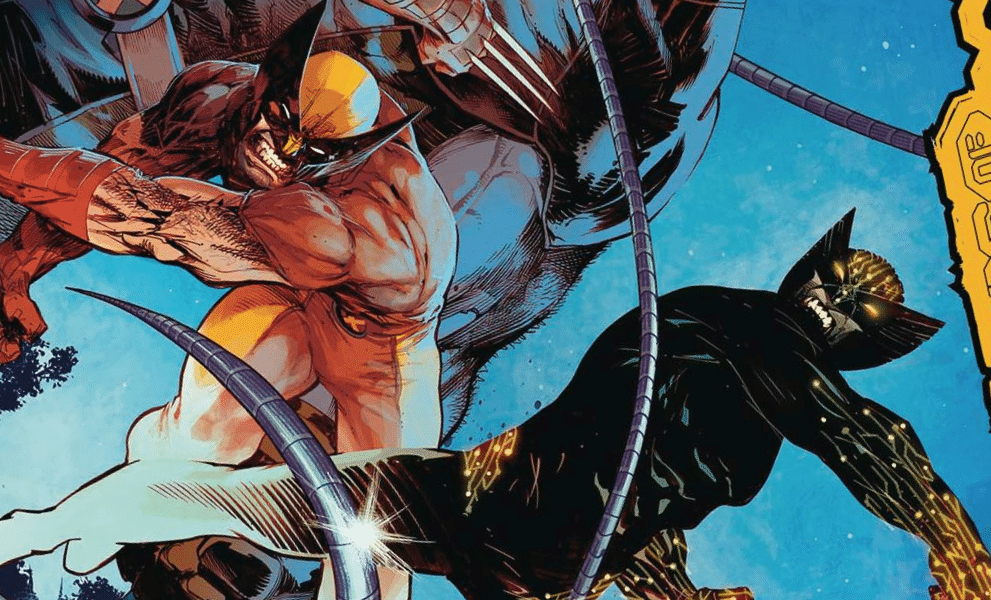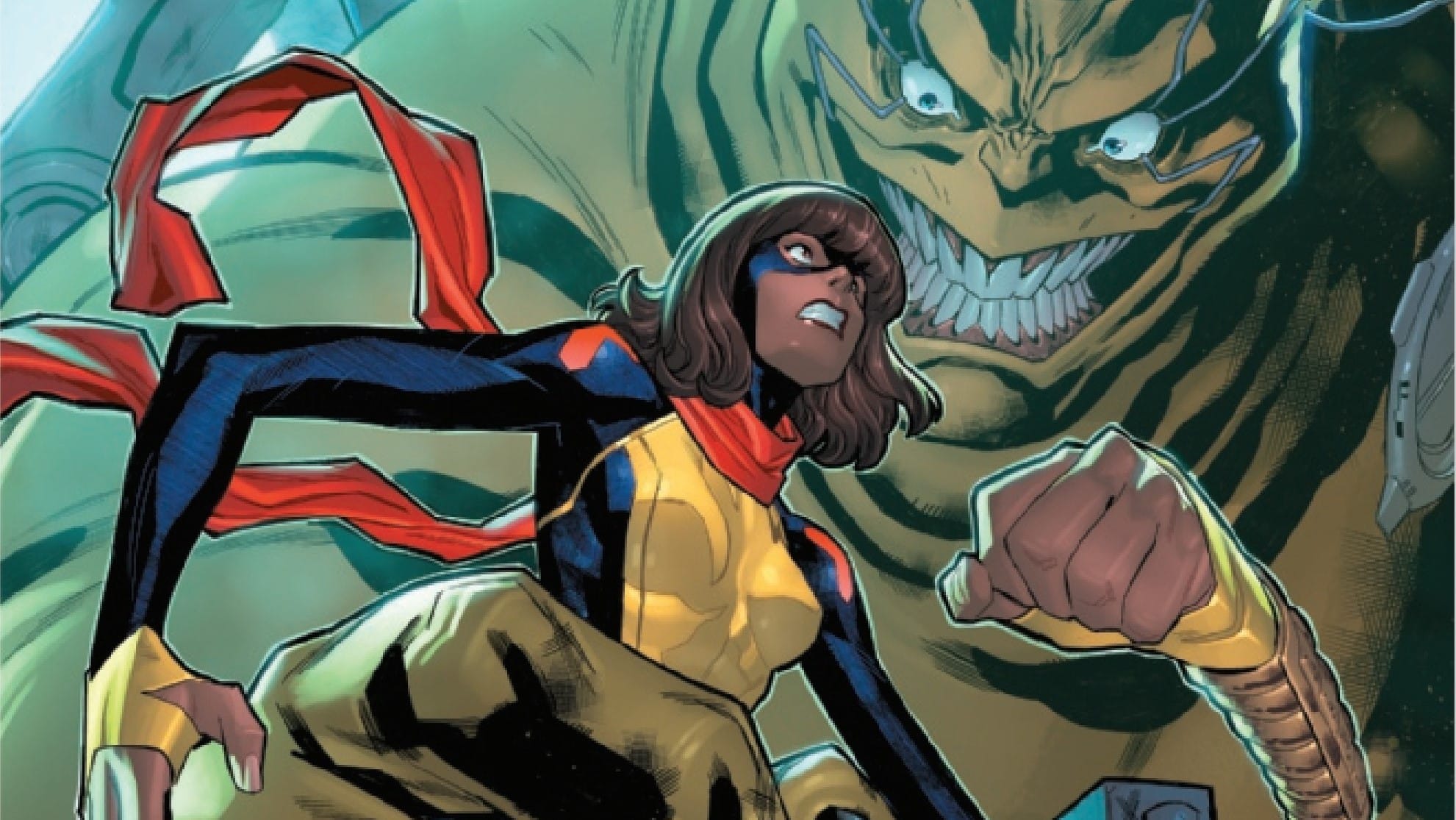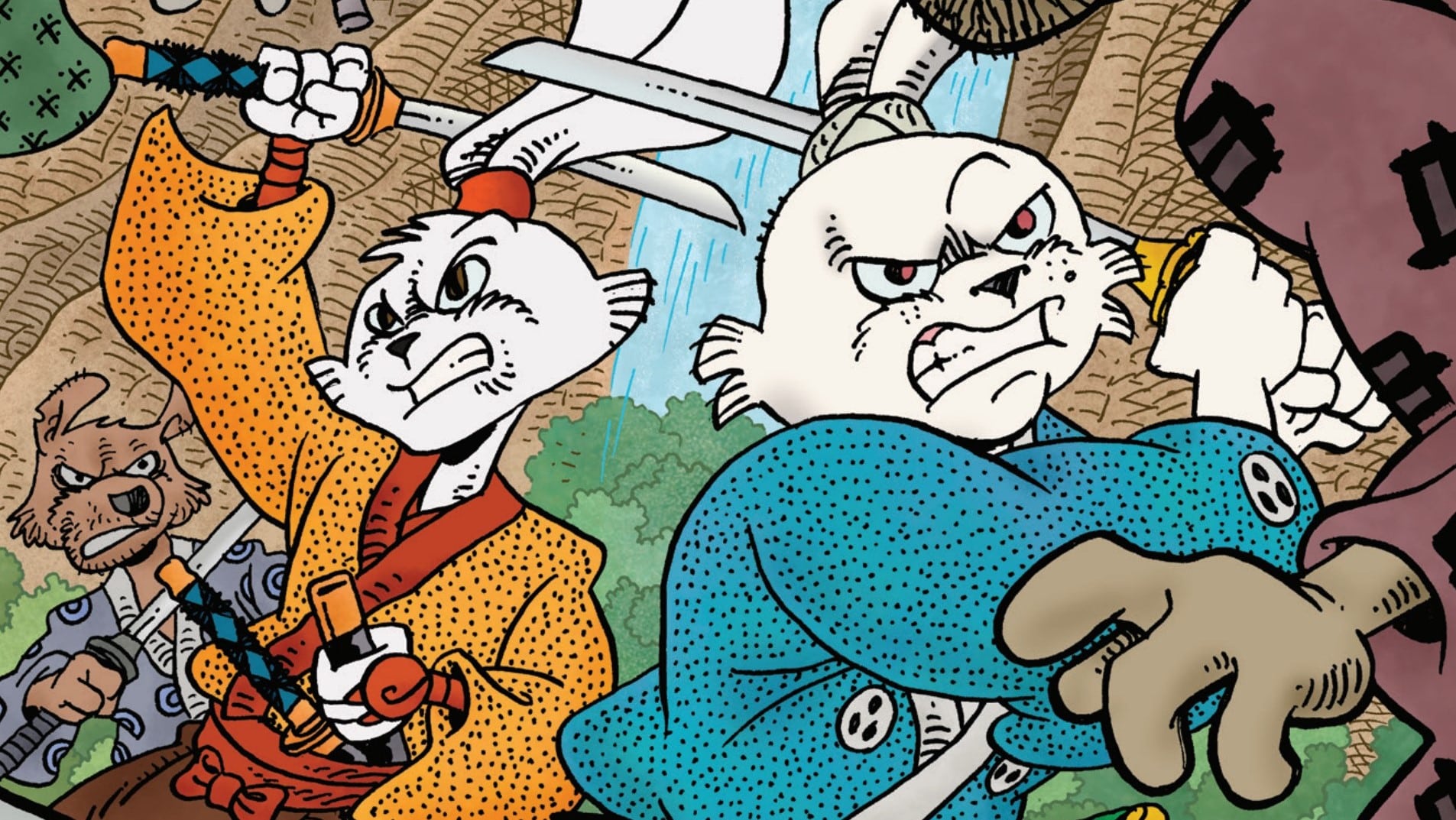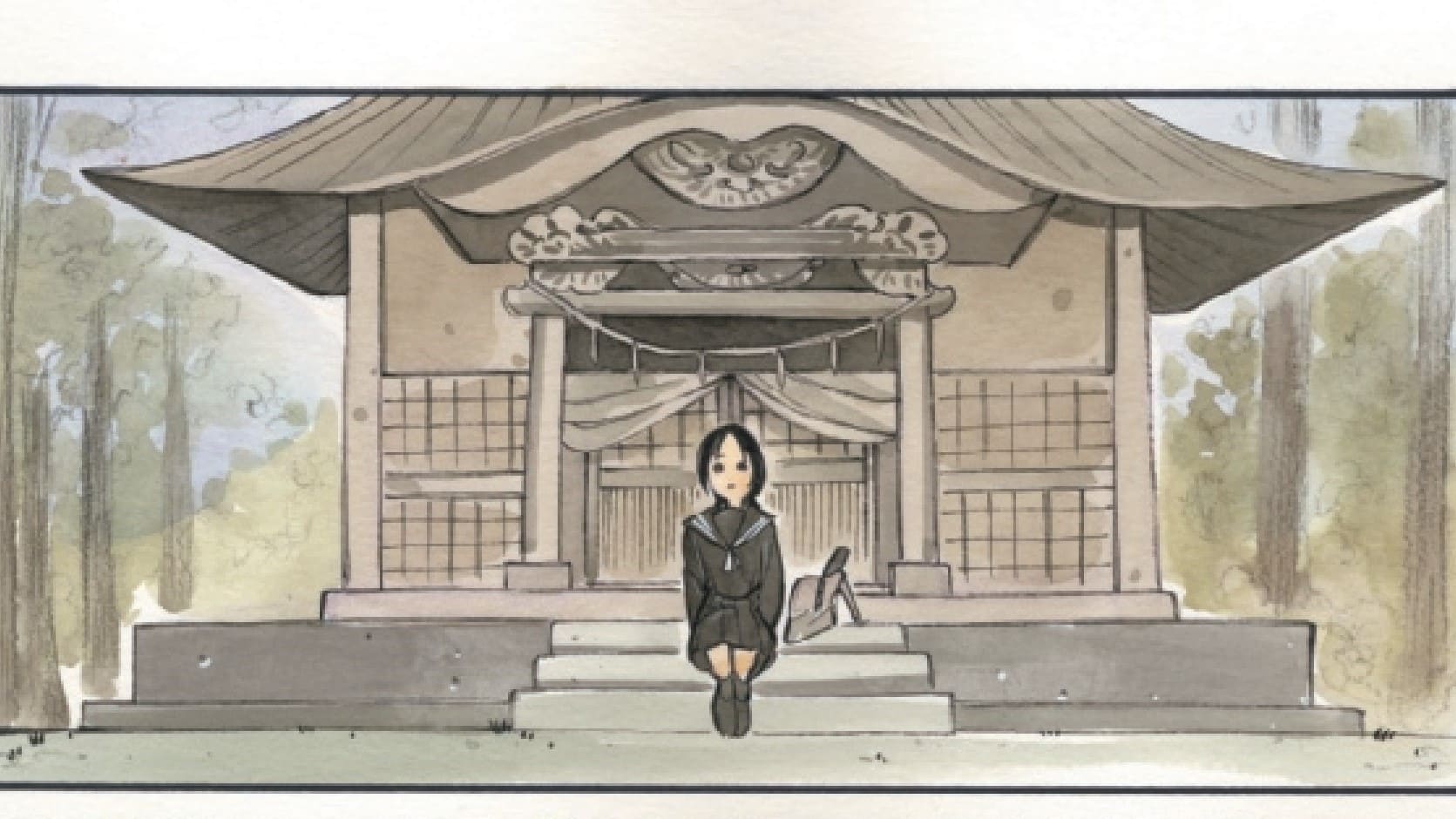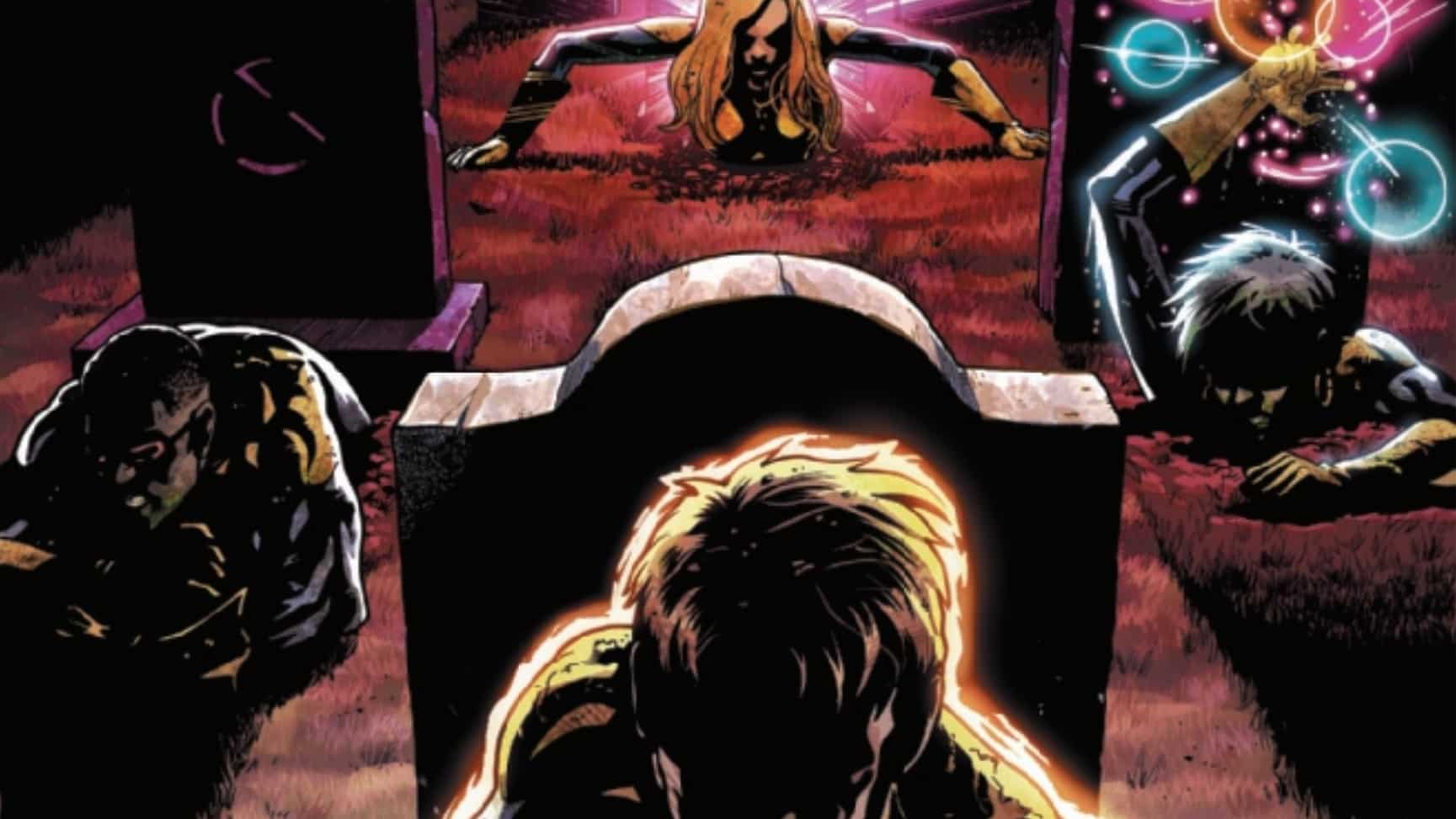Wolverine and the Wolverines fight Wolverine and it’s the Wolverine-iest as the series concludes in X Deaths of Wolverine #5, written by Benjamin Percy, art by Federico Vicentini, colored by Dijjo Lima, and lettered by Cory Petit.
Chris Eddleman: Well, our ten-week crossover is now at its end, and we’re here to sift through the pieces. I’ve got a lot of varied thoughts on this often exciting, often baffling, and generally whelming double miniseries, and we’re fortunate enough to share them here. Austin, let’s dive in on the X-est death of Wolverine.
Austin Gorton: Severed arms, possessed sperm whales, faces coming off…it’s certainly had a fair share of eye-catching moments. Can it stick the landing? Is there even a landing to stick? Let’s find out!
The End of Omega

Chris: So, this issue wasn’t quite what I was expecting, and yet exactly what I was expecting at the same time. And while I think we’re going to touch on the concepts of expectations and “promises” in these serial superhero stories, let’s talk first about the text.
After stabbing Moira last issue, Omega Wolverine has unfortunately been “cured” of his healing factor and is now a Phalanx drone, and every other Wolverine and Wolverine adjacent character is trying to stop him from infecting Krakoa as a whole.
But anyway, we open on Moira having a dream sequence while bleeding out, which is that same carnival scene from House of X/Powers of X where Moira reveals herself to Charles. But this time she is absolutely cursing him instead. This scene feels part fun callback/part creation of a villain I suppose. I’m still not entirely sure whether Moira’s entire aims during the Krakoa era were meant to be self-preservation or at least halfway altruistic, but it’s clear that the subversion of her plans by the purposeful aims and careless ineptitude by Charles Xavier has kind of thrown our enigmatic immortal off the deep end here. Austin, what are your thoughts on this callback?
Austin: All else aside, the image of a bloodied Moira stumbling up to a blissfully ignorant Xavier watching the birds while sitting on that semi-infamous bench and telling him to eff off might have made all ten issues of this crossover/event/whatever worth it.
That aside, you’re right: this whole little three-page cold open, which is basically Moira’s (seemingly) dying moments, seems like a mini origin for a villain: she tried to do right by mutants, Xavier effed it up, and now she’s dead. We’ll get into the Moira of it all here shortly, but in terms of structure, it’s a smart way to keep Moira at the center of things as the story’s final chapter kicks off (a chapter in which Moira otherwise barely appears): despite the name on the title, this half of the crossover has pretty much been Moira’s story, and this opening reminds us of that just before it hands the bulk of the issue over to big Wolverines brawl.
Chris: So as all of us know, the X-Men are a team and accomplish things together but also, sometimes Wolverine is just kind of the main character of things with a few helpers and this seems to be no exception to this rule. I feel like the inclusion of Laura, Gabby, and Akihiro is mostly just to have a big Wolverine family taking on our poor robot Wolverine and maybe also to justify the name on the tin. But of course, this all moves back to Logan, who is the only one who can defend Krakoa against himself. Wolverine has become a perpetual martyr in X-Men, and we get heaps of that motif through the tell-don’t-show X Deaths sequence in the data page as well as his internal monologue about needing to atone for his own sins (in this case ones he hasn’t even committed yet). I feel like that’s what is binding the two miniseries together, Wolverine’s duty and guilt, but that isn’t really new. I’ve complained about this before but this series feels more like a celebration of Wolverine as a concept to me than an actual compelling narrative (any semblance of that to me comes from Moira’s odyssey). I’m likely being too harsh but, we’ve now had two endings where we end things red in tooth and claw along with some harsh inner monologue.
Austin: Both the “centering” of Wolverine in the narrative and the way his life seems to be a series of unending conflicts definitely read like the series’ conclusive statements. In the same way that HoXPoX, via Cerebro and the Five, made the fact that comic book characters rarely stay dead because of the demands of the serial comic book format part of the series’ in-universe text, the lesson Wolverine seems to have come away with (or at least is emphasizing) here seems to be making a textual acknowledgment of a real-world reality: unwilling to toast victory because the fight’s never really over, he says “there’s always more mayhem waiting around the next bend in the trail”. This seems like an acknowledgment of the fact that, for these characters, there is no end – no ultimate victory (or defeat) – because there’s always another fight just around the bend.
Percy seems to be suggesting here that’s a feature, not a bug, of these stories (or, at least, both), but that inability for anything to end, while always true of comics, seems to have been thrown in heightened relief during the Krakoa Era, particularly in the wake of Hickman’s departure, a departure seemingly motivated by his acceptance that he’d created a new status quo and not just the opening act of a complete story. I don’t think Percy is speaking directly to Hickman’s sentiment (pro or con) with that line, but it stuck out to me in light of the discord surrounding his departure specifically and the current state of the X-books more generally.
Similarly, Beast’s takeaway from all this is that, ultimately, stabbing shit is what saves the world (which feels similarly metatextual, intentionally or not), and that’s what makes Wolverine so special (the best there is, so to speak). Again, I want this to be the start of a conversation that will be continued in later stories (ie is Beast right? If so, what do we do about it? etc. ), but I feel like it’s more likely meant to just be a period on this story, and not a question mark, especially coming as it does from the writer of the ongoing Wolverine book. If the ultimate point of these ten issues is to answer the question “why is Wolverine so great?” and the answer it comes to is “because he’s good at stabbing” well, it’s hard not to feel underwhelmed by that.
Mustache Twirling Moira

Chris: So we end on a shot of Moira literally coming out of her own tomb, all robotic and poised for vengeance. Earlier in our reviews, Liz Large speculated that Moira was going to be some kind of synthesis point on which robots, mutants, and humans would find commonality. However, this now seems to be a very villainous Moira, a combination of both the organic and technologic enemies of mutantkind. Austin, I have to confess that at the very least, this feels a bit like a regression in terms of character concept. One of the big twists of Inferno was that Moira was working to cure mutantkind the entire time, as she feels like it would be the closest thing to a “mercy” after seeing thousands of years of repetitive death. While I wasn’t fully convinced that a character who created a perfect mutant society was doing so as a side effect to a form of genocide, I think this incarnation so far feels like a simplification. We have a Moira at the end of this story vowing revenge on those X-Men once and for all. And don’t we have several half-humans who are doing the same? I’m a little let down.
Austin: Obviously, as in all the talk up above about how none of this stuff ever ends, even though a finite story might end, it remains to be seen where this Moira stuff is going, and there’s still the potential for it to go somewhere interesting. But on the surface, with where things are left off now, I’d be lying if I said I wasn’t a little disappointed too. There are some mildly intriguing ideas here – it seems like Moira set up a time delay transfer of her consciousness to a robot body ie the technological version of the Krakoa rebirths, which has some potential as an example of the ongoing game of one-upmanship between humans/robot intelligence and mutants that has been an undercurrent of the Krakoa Era – but ultimately, in terms of a character arc, all this really did was take the “yeah, she’s less virtuous than we thought” Moira of “Inferno” and flatten her out into more one-dimensional arch villainy. The “I just wanted to cure mutants before they were ever mutants!” Moira of “Inferno” was at least mildly sympathetic (especially when we remember her best life was her first one before she knew she was a mutant). This Moira is much more akin to a basic mustache-twirling, monologuing, anti-mutant super-villain, one who – notably – blames everyone else for her actions/problems, in true super-villain fashion. It’s not (yet) clear what has been gained from this transition.
I’m also not sure what has changed in terms of Mecha Moira’s statement that she no longer needs to reboot the timeline to change the future? I don’t think anything has changed regarding our/the characters’ conceptions of how time travel and Moira’s previous mutant power worked as a result of this series? This is just standard villain posturing (especially since she lost the ability to reboot time in “Inferno”), right?
Chris: Yeah, this is her “eleventh life” as it were, and thus she will have no more as far as we’re aware. But yeah, this feels as you said, a bit flat, and that’s generally how I feel about the ending as a whole.
“There’s Always More Mayhem Waiting”

Austin: One of the things current comics in particular have to deal with is the potential disconnect between how a story is teased and how it actually plays out. Because modern marketing involves interviews with creators and previews from editors and whatnot (often via sites like this one!) a lot of readers – even the especially spoiler averse ones – will go into any given high profile story with some set of expectations. How the story meets those expectations often colors the takeaway from the story (through little fault of its own). I find myself struggling with that here, as I had the impression going into X Lives/X Deaths that this was going to be, if not on the level of HoXPoX or “Inferno” in terms of significant narrative happenings, at least a bigger deal than a randomly monthly story. But in the end, it feels like a five-issue arc of Wolverine plus a five-issue arc of X-Force with Moira positioned as the central villain that got gussied up into an “event”. Which is probably what happened, but then that got turned around and sold to readers as being The Next Big Thing.
To be clear, there were plenty of individual moments throughout these ten issues I enjoyed – Omega Dick! – but while I enjoyed it on a micro-level, taking a step back and viewing it on the macro, big picture, level, it feels somewhat lacking. It affirmed Wolverine’s status as a Big Deal (which we already knew), it pushed Moira deeper into the realm of out-and-out villainy (a development which still may pay off but seems dubious at the moment), and gave us some fun moments. That’s more than enough happenings for a random story arc in an ongoing series, but these ten issues were billed as something bigger than that.
Is this just a “me” thing I need to get over, Chris, or do you feel like your reaction to X Lives/X Deaths on the whole has been colored by your expectations going into it?
Chris: No this definitely feels a little bit more like treading water than the promise that this was going to set up a big new paradigm. Frankly, if this ten-week series hadn’t happened, our characters would be roughly in the same place, I guess minus the death of Omega Red and the “chewing out” of Mikhail. Moira is still at large, is positioned as an enemy, and Wolverine is still Wolverine.
So yeah, I agree with the “on a macro level, on a micro-level” assessment that you have. But I kind of want to talk about how this miniseries felt on a macro level a little bit more. The manifesto that begat Krakoa talked about cycles, and how X-Men stories tend to fall into them. And that’s something almost any reader can observe if they look at two different eras of X-comics. They’re inevitably on top for a bit, get some bigotry of some kind or another, and then are on the back foot. The cycle of genocide or death churns on and on. Krakoa gave mutants a new paradigm as a group who is seizing their destiny, and are now immune to death. It felt fresh and new off the bat but, with a few years behind us and at the tail end of a miniseries, I’m starting to think we’ve entered a new trap. The human enemies of mutantkind are numerous, and they each kind of come to the forefront for a story, and then back off for a bit only to come later. But now mutantkind has a cooler base and more mutants to choose from for a roster. I’m starting to feel a hint of staleness set in. I know tons of that was due to Covid but, it’s hard to hear that a story is going to bring the brand new ideas when it feels like we’re just doing more typical X-Men stuff but this time it’s island-flavored. I’m worried about what we’re losing as we keep in this phase. It’s not that this was bad, it was just, safe to me.
Austin: There is a definite sense of safety here – and maybe, given this was, all other promotion aside, constructed as a ten-week series involving the franchise’s most popular and marketable character slashing his way through time, we’re both a little dumb for expecting it NOT to be exceedingly safe. Really, this gets back to Wolverine’s assertion at the end of the issue, that “there’s always more mayhem waiting around the next bend in the trail”: the serial nature of these stories prevents anything from truly ending – there’s always more mayhem, another villain to fight, another issue to sell, another event to promote. The dawning of the Krakoa Era suggested, if not a break from that pattern (because that pattern can’t be broken so long as Marvel wants to keep publishing X-books), at least some new riffs on the old material. But even those newer riffs are, to your point, getting a bit long in the tooth at this point.
Is Percy – through Wolverine – hanging a lampshade on this idea at the end of the story the beginning of a reckoning with that reality? Not likely. But perhaps this was never meant to be the series to reckon with it or to liven up those riffs again. In that context, it’s certainly a failure. But in the context of being a dumb-fun Wolverine story with minimal-to-no repercussions on the arch narrative and making no effort to do anything with the current status quo other than exist in it? It gets the job done.
Who’s to blame for that disconnect: Percy, for not aiming higher, Marvel’s promotional department, for leading us astray, or us, for not knowing better? Probably a little bit “all of the above”. None of which changes the fact that this is largely a series that never really presents a “whole” better than the “parts” of its best one-off moments.
X-Traneous Thoughts
- The John Cena reference here is a bunch
- Scout trying to “work smarter” and just drop a boulder on Omega Wolverine (even if it failed) was fun.
- Sage pointing out that Beast giving Wolverine all the credit ignores her contributions (which were not insignificant in terms of defeating Omega Wolverine) is also a fun moment, but I can’t decide if Percy is just skewering Beast, taking the piss out of his own argument that Wolverine is The Best, or just trying to be funny.
- I’m generally not someone who likes to write a different version of a story in my head while I’m reading it, but the first data page in this issue, which describes some of the notable “X Deaths” which occurred in the future of Omega Wolverine, nevertheless inspired me to wonder what if each of the first few issues of the series opened by showing readers one of those deaths, without making it clear when/why they were happening until the full reveal of Omega Wolverine and the future timeline? At which point it would become clear what we were being shown and that averting them is what the mission had been about all along, thereby giving the series its title? I feel like I’d have liked that more.
- Oddly comforting to see a list of titles with release dates next to them at the back of an issue again.

